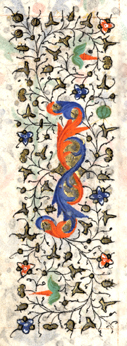About

The Global Medieval Studies Program at Georgetown University offers an interdisciplinary undergraduate minor and major focused on the period from roughly the official Christianization of the Roman Empire (4thcentury C. E.) and major advances of Buddhism in China during the Six Dynasties period (3rd-6th centuries C.E.) to the year 1500. The Program’s faculty and courses are drawn from sixteen different disciplines within the University, with predominant emphasis on the interrelations among art, history, philosophy, theology, and literature. Though the focus of the course offerings is predominantly on the Western Middle Ages, there is increasing representation in comparable periods in non-Western cultures.
Georgetown’s location offers students a rich field of opportunity for exploration of medieval art, music, and literature beyond the University: at the National Gallery of Art, the Freer and Sackler Galleries of Asian art, Dumbarton Oaks, the Library of Congress exhibits, the Folger Shakespeare Library, Baltimore’s Walters Art Gallery and, within reach, the major museums and collections of New York, especially the Metropolitan Museum of Art, the Cloisters, and the Pierpont Morgan Library.
The students in the program sometimes attend academic conferences on the Middle Ages as far away as New York and Boston; they serve as indispensable assistants at the medieval conferences that the program has sponsored at Georgetown. In the past, the Medieval Club organized an annual Medieval Banquet for over 100 participants, with dishes prepared from authentic medieval recipes, and with medieval entertainments.

From 2004 to 2008, the Global Medieval Studies Program hosted the Annual Conference of the Charles Homer Haskins Society for Viking, Anglo-Saxon, Anglo-Norman and Angevin History. In spring 2012, under Global Medieval Studies’ sponsorship, the renowned Benjamin Bagby visited Georgetown, met with students, and performed his creative recitation of Beowulf accompanied by a medieval lyre. In the fall of 2013, one of our faculty organized a Boccaccio Symposium. In 2014-15, two of our faculty hosted a series of Critical Silk Road Studies seminars. In the fall of 2017, Global Medieval Studies will be hosting a symposium in honor of Irfan Shahid, jointly sponsored with Dumbarton Oaks. In the spring of 2018, we hosted a symposium on Climate Change in the Little Ice Age, co-sponsored with the Georgetown Environment Initiative.
Learning Goals and Outcomes
We share many of the learning goals which our contributing departments have articulated, in addition to some goals which are more specific to Global Medieval Studies.
Goals
- Students will engage the fundamental building blocks of civilization and cultural development found in the study of things medieval, such as studying and examining the roles of so-called “barbarians” as the Vikings and the Mongols, the continuation of Mediterranean trade, banking, and production after Rome’s collapse, the Silk Road, China’s breakthroughs in practical technology and money economy, the transmission of Hindu numbers and mathematics to the Islamic and Christian worlds, the medieval European university and its non-European equivalents, and the questioning gender relations first constructed and contested in “courtly love” from Japan to France
- Students will learn the practice of interdisciplinary approaches and how the nature of the evidence for Global Medieval Studies necessitates genuine interdisciplinarity, not just the accretion of separate disciplines.
- Students will deepen their understanding of the roots and branches of Islam, Judaism, Christianity, Hinduism, and Buddhism in all their diversity, mutual influences, conflicts, and coexistence.
Outcomes
- As culturally literate global citizens, students engage with the living influence of the Middle Ages in modern cultures through such institutions as the state, gender roles, law, banking, vernacular literatures, and the university itself. Students can serve a world beyond themselves equipped with a deepened awareness of how much of the medieval survives in current institutions and why it matters.
- From their academic specialization, students can develop the ability to observe, describe, analyze, and interpret medieval art, artifacts, documents, and literatures both as individual fields of study and as interrelated evidence of past thought, aesthetics, production, and attitudes.
- Students can deepen their abilities to understand, question, and appreciate societies removed in space and time from the students’ own cultures: the alterity of the Middle Ages equips us to better understand the long history of modern issues of tolerance and difference.
